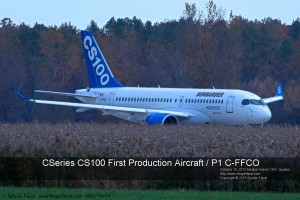Leeham News and Analysis
There's more to real news than a news release.
Leeham News and Analysis
- Boeing ponders 16/mo production rate for 787
- At long last, Boeing appears near certification and EIS for 777X
- Air India Flight 171 Preliminary Crash Report Is Unclear Regarding Pilot Actions
- Bjorn’s Corner: Air Transport’s route to 2050. Part 30.
- It’s official: MTU’s engine leader named CEO of Airbus Commercial from Jan. 1; future of Open Fan and A220-500 shifts to him
Bombardier earnings preview
Subscription required
Introduction
Feb. 16, 2016, © Leeham Co.: Bombardier’s fourth quarter and full year 2015 financial results will be reported Wednesday, and we don’t expect the situation to be pretty.
Wednesday, and we don’t expect the situation to be pretty.
Yes, officials will highlight the recent closing of the sale of 30% of the Transportation (Rail) subsidiary.
Yes, the C Series is now on a world tour and appearing at the Singapore Air Show this week.
Yes, the CS100 will enter service in the second quarter.
Yes, the CS300 should be certified, delivered and enter service before the end of this year.
But missing will be any concrete information about new orders.
Summary
- Still no C Series orders since September 2014.
- Bombardier has its hand out for more government aid.
- ATR is making a new push in China and North America, the latter a stronghold for the Q400.
Posted on February 15, 2016 by Scott Hamilton
Pontifications: Bad week for aerospace stocks
Feb. 1, 2016, © Leeham Co. Ouch.
Boeing stock tanked about 10% last Wednesday when the company surprised analysts with unexpected news and below expectations 2016 guidance.
Bombardier became a penny stock.
What the heck happened?
Posted on February 1, 2016 by Scott Hamilton
The turbo-prop conundrum: small market, high costs

ATR Turbo-prop. Photo via Google images.
Subscription Required
Introduction
ATR and Bombardier are incumbents. China has a home-market offering.
Indonesia and India want to create a product.
It’s the 60-seat and up turbo-prop market.
It’s too many companies chasing too-small a market.
Summary
- The 20-year demand for 60-99 seat turbo-props is small.
- Developing a new, clean-sheet design is costly.
- There is a solid demand for an inexpensive 19-34 seat turbo-prop—but nobody is interested.
Posted on November 23, 2015 by Scott Hamilton
Evaluating airliner performance, part 1.
By Bjorn Fehrm
Subscription required.
Introduction
Sep. 21 2015, ©. Leeham Co: Comparing and evaluating operational and economic performance of competing airliners is a complex task that requires analysis of thousands of parameters.
It’s not unknown for smaller airlines to have limited capability to undertake these difficult analyses. Accordingly, they often rely on the Original Equipment Manufacturers (OEMs) for their analysis on behalf of the potential customer.
Unfortunately, the OEM’s have little incentive to provide an unbiased view of either their products nor those of their competitors.
Thorough evaluations require quite some preparations. If these preparations are not carried out correctly, the result can be biased to the extent that the evaluation method dictates which’s the best aircraft and not the most suitability aircraft for the task. We will in a series of articles cover how aircraft evaluations are done and how evaluation pitfalls can be avoided.
Summary:
- Aircraft evaluations are made for all direct operating costs that can be linked directly to the operation of the airliner.
- The costs can be divided in Cash Operating Costs (COC), which covers the operation of the aircraft and capital costs. Combined these costs constitute the Direct Operating Costs, DOC.
- The OEMs produce data for all COC cost items, but they do that in their own way. To make the costs comparable one need to know and understand their assumptions and neutralize these through independent modeling of the costs.
- We describe what these assumptions are and how to neutralize them.
Posted on September 21, 2015 by Bjorn Fehrm
ATR selling their 1,500 ATR turboprop to Japan Airlines.
By Bjorn Fehrm
Introduction
June 15. 2015, C. Leeham Co: ATR said its turboprop product has broken a barrier that was thought impossible for regional turboprops at its Paris Air Show press briefing today. It was a company telling about being in a strong market and enjoying a market leading position. ATR sold its 1500th aircraft to Japan Airlines Commuter (JAC), the regional daughter of Japan Airlines. JAC signed for eight ATR 42 to replace the Saab 340 fleet. JAC also holds options for a further 15 aircraft. The order was the first for ATR aircraft to Japan.
ATR, which is owned 50:50 by Airbus and Finmeccanica of Italy with headquarters in Toulouse, is dominating the under 90 seat worldwide turboprop market. ATR said that it will unveil business for 46 aircraft during the air show with 35 options as it continues to dominate the world market for turboprops which seats up to 90 passengers. ATR claims it has controlled 77% of the market since 2010 to date and that its customer base during that time was 51 customers versus nearest competitor’s 24.
Posted on June 16, 2015 by Bjorn Fehrm
Paris Air Show: Qatar and others
Subscription required.
Introduction
June 1, 2015, c. Leeham Co. It could be called the Qatar Airways Air Show.
Qatar Airways plans to have five airliners on display at the Paris Air Show in two weeks: the Airbus A319, A320, A350, A380 and the Boeing 787. The carrier hasn’t  announced whether it will provide an aerial display as it has at previous air shows, but Qatar may well have more airliners there than Airbus or Boeing.
announced whether it will provide an aerial display as it has at previous air shows, but Qatar may well have more airliners there than Airbus or Boeing.
As for manufacturers other than Airbus and Boeing, we don’t expect anything of consequence from these.
Summary
- Irkut, COMAC, Mitsubishi, Sukoi and ATR are other major aircraft producers that will be at the Paris Air Show.
- Engine makers CFM International, GE Aviation, Rolls-Royce, Pratt & Whitney and Engine Alliance will also be there.
- An update on Airbus expectations.
Posted on June 1, 2015 by Scott Hamilton
Airbus, ATR, Boeing, Bombardier, CFM, Comac, Embraer, Emirates Airlines, Irkut, Mitsubishi, Paris Air Show, Pratt & Whitney, Premium, Qatar Airways, Rolls-Royce, Sukhoi
787, A319, A320, A350, A380, Airbus, ATR, Boeing, CFM, Comac, Emirates Airlines, Engine Alliance, GE Engines, Irkut, Mitsubishi, Paris Air Show, Pratt & Whitney, Qatar Airways, Rolls-Royce, Suhkoi, Tim Clark
Next Gen turboprop R&D continues at Pratt & Whitney
Subscription Required
Introduction

Maria Della Posta, SVP Sales and Marketing, Pratt & Whitney Canada
April 5, 2015, c. Leeham Co. Pratt & Whitney Canada (PWC) continues to develop the next generation turbo prop engine despite little interest from Bombardier for a replacement for its slow-selling Q400 or from Airbus, 50% owner of ATR, dominant producer of this type of aircraft.
Maria Della Posta, SVP of sales and marketing, said PWC is confident demand will prevail over the current lack of interest to see a new airplane program launched as early as 2016 or 2017–though she hedges that this could slip a year or two.
Summary
- In the meantime, PWC continues to undertake Performance Improvement Packages (PIPs) for its ubiquitous PW100 series that is now in its 38th iteration.
- Emerging market ambitions could create new opportunities for PWC to put its next engine on new entrant turbo prop producers.
- Airlines seek a new, larger turbo prop than the Q400 and ATR 72.
Posted on April 5, 2015 by Scott Hamilton
Bombardier changing the message on the Q400 to emphasize flexbility
March 19, 2015: C. Leeham Co. Bombardier’s current challenges don’t end with the CSeries. The company has seen its once-dominate positions in the regional jet and turbo prop markets decline precipitously.
The CRJ struggles in its sales against the Embraer E-Jet. The Q400’s market share of the turbo prop sector has declined to a mere 10% of the backlog vs ATR.
Still, Ross Mitchell, vice president of Business Acquisition and Commercial Aircraft for Bombardier, gave a spirited defense and upbeat outlook of both products during last week’s ISTAT conference in Phoenix. In a one-on-one interview the next day, we posed a series of questions about the CRJ and the Q400. Today’s report is about the Q400. Tomorrow’s will be about the CRJ.
Posted on March 19, 2015 by Scott Hamilton
CEO Interview: ATR chiefs says no 90-seater without Airbus support
March 3, 2015, c. Leeham Co: ATR, the turbo-prop OEM 50% owned by Airbus and 50% by Finmeccanica, wants to develop a new airplane to replace the venerable ATR 42/72 series that entered service in 1985 and 1989 respectively..
Airbus, as half owner, has the power to block the plan–and it has, saying that because ATR has 85%-90% of the market, a new airplane isn’t needed.
Despite this huge market share, ATR CEO Patrick de Castelbajac says ATR doesn’t “own” the market. The need for a larger, 90-seat turbo-prop mirrors an industry trend toward up-gauging and the ATR 72 has been stretched probably as far as it can go, says de Castelbajac.
But if Airbus isn’t on board, development of a new airplane isn’t possible, he says.
Posted on March 3, 2015 by Scott Hamilton
Regional operations with the Turboprop, propjet or Jet; Part 2.
By Bjorn Fehrm
Subscription required
Introduction
15 Feb 2015: In Part 1 of this article series we started comparing the alternatives available for turboprop short haul services in the 70 seat segment; ATR72-600 and Bombardier Q400. We also included the closest regional jet, CRJ700 from Bombardier, to compare costs and see where a jet would be ![]() needed to keep trip times within reason.
needed to keep trip times within reason.
In Part 1 we went through the capacity of the aircraft and their basic characteristics. We also did a first check of their typical fuel consumption on a standard mission of 300 nautical miles.
We will now look closer at the economics of the aircraft; we fly them over different sectors with different speed profiles. We will also dissect their Cash Operating Costs (COC) and Direct Operating Cost (DOC). Having done all this we will look at the crossover points; for what market is ATR72 the choice and where does Q400 fit. And finally, what route sectors require a jet?
Summary:
- The ATR72-600, Bombardier Q400 and CRJ700 are quite different aircraft. The monikers turboprop, “propjet” and jet fit them well.
- The positioning of the end of the scale products are clear, the intriguing aircraft is the Q400. When does it makes sense and has Bombardier positioned it correctly?
- How does one explain its recent meager sales? Wrong aircraft at wrong time? Weak sales force? Wrong markets?
Posted on February 15, 2015 by Bjorn Fehrm




